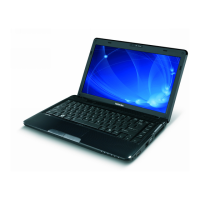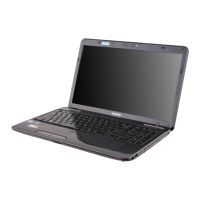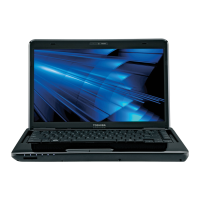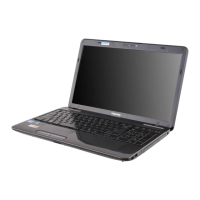
Do you have a question about the Toshiba Satellite L675 and is the answer not in the manual?
| Optical Drive | DVD SuperMulti drive |
|---|---|
| Wireless | Wi-Fi 802.11b/g/n |
| LAN | 10/100 Ethernet |
| Webcam | Integrated Webcam |
| Processor | Intel Core i3 / i5 / i7 (various models) |
| RAM | 4GB DDR3 |
| Storage | 500GB HDD |
| Display | 17.3-inch HD+ TruBrite LED Backlit display |
| Graphics | Intel HD Graphics |
| Operating System | Windows 7 Home Premium (64-bit) |
| Battery | 6-cell Li-ion |
| Weight | 6.6 lbs |
| Dimensions | 16.3 x 10.6 x 1.5 inches |
| Ports | 3 x USB 2.0, 1 x HDMI, 1 x VGA, Headphone, Microphone |
Lists hardware and documentation items to verify before starting computer setup.
Details the pre-installed Windows operating system and utility software.
Provides instructions and safety precautions for connecting the AC adaptor.
Explains how to turn on the computer's power.
Describes the procedures for shutting down the computer in different modes.
Explains the system recovery partition and how to access its tools.
Provides steps for creating recovery media (DVD or USB Flash Memory).
Illustrates and describes the computer's front view with the display closed.
Details the ports and features located on the computer's left side.
Details the ports and features located on the computer's right side.
Illustrates and describes the components on the computer's underside.
Shows and explains the computer's components with the display open.
Explains the function of various system and keyboard indicators.
Describes the computer's hardware components like processor, memory, and disks.
Details TOSHIBA Component features pre-installed on the computer.
Describes pre-installed utilities and applications and how to start them.
Lists optional devices that can expand computer capabilities and versatility.
Explains how to use the Touch Pad and its gestures for navigation.
Describes the Web Camera features and usage.
Explains how to register and use facial recognition for Windows login.
Details how to use optical disc drives for playing CD/DVD/BD media.
Describes the basic typewriter keys and their computer keyboard differences.
Explains the function keys and their programmed operations.
Describes key combinations for enabling or disabling computer features.
Details how power conditions affect computer operation and battery status.
Explains the meaning of the battery indicator lights.
Provides procedures and precautions for recharging the battery pack.
Offers tips to improve battery life and operating time.
Explains how to run the TOSHIBA HW Setup program.
Details how to set or reset the user password for power on.
Explains how to set the priority for booting the computer from various devices.
Provides guidelines for identifying and resolving computer problems.
Suggests simple solutions for common issues before deeper troubleshooting.
Lists common problem areas related to computer hardware and peripherals.
Explains issues related to processor overheating and automatic shutdown.
Details operating and non-operating temperature and humidity conditions.
Lists the technical specifications for the Wireless LAN card.
Describes radio characteristics of the Wireless LAN module and regulations.
Lists certification agencies for AC power cords in different regions.
Provides performance legal footnotes for the Central Processing Unit (CPU).
Explains main system memory usage and limitations.











